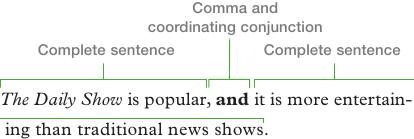Coordination and Subordination
Joining two sentences with related ideas can make your writing less choppy.
Coordination
In coordination, two sentences can be joined with a comma and a coordinating conjunction, a semicolon alone, or a semicolon and a conjunctive adverb.
| TWO SENTENCES |

|
| JOINED WITH A COMMA AND COORDINATING CONJUNCTION |

|
| COORDINATING CONJUNCTIONS | |||
| for | and | nor | but |
| or | yet | so | |
| JOINED WITH A SEMICOLON ALONE |

|
| JOINED WITH A SEMICOLON AND A CONJUNCTIVE ADVERBS |

|
| CONJUNCTIVE ADVERB | ||
| also | however | moreover |
| as a result | in addition | still |
| besides | in fact | then |
| furthermore | instead | therefore |
Subordination
With subordination, you put a dependent word (such as after, although, because, or when) in front of one of the sentences, which then becomes a dependent clause and is no longer a complete sentence.
| TWO SENTENCES |

|
| JOINED THROUGH SUBORDINATION |

|
| JOINED THROUGH SUBORDINATION |

|
| SUBORDINATING CONJUNCTIONS (DEPENDENT WORDS) | ||
| after | if | unless |
| although | if only | until |
| as | now that | when |
| as if | once | whenever |
| because | since | where |
| before | so that | while |
| even if/though | ||
[Leave] [Close]